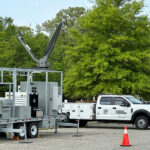When the average citizen is confronted by an emergency situation beyond the routine, he or she is usually overwhelmed and forced to rely on emergency responders to take command and re-establish control. Unfortunately, the first responders themselves do not always have the same option. Their first task, usually, is to restore some degree of order over the situation – but they must first impose an even higher degree of order on themselves. For that reason alone, when sudden disasters reach such magnitude not only are the average citizens on the scene overwhelmed, but also the internal resolve of professional responders (and response agencies) need all of the tools required to carry out their work.
To meet that daunting challenge, the leaders of first-responder agencies must plan, equip, and practice for major events in such a way that the responder personnel are less likely to be overwhelmed – and, of even greater importance, can continue to function at a high level of efficiency.
The advance planning required starts, of course, with routine day-to-day operations and expands into the specialized field of disaster management. Whatever the situation, all plans should be based on what is usually the same and very specific set of goals: restore order and save lives. With the correct organizational structure in place, planners can expand a supposedly “typical” day-to-day plan to meet and deal effectively with rapidly escalating situations. More importantly, when responders understand both the goal and the guidelines, they can use and quickly expand upon the same plan when an incident escalates to the “overwhelming” point mentioned earlier. That type of plan, and the attitude it fosters, allows responders to focus on goals already familiar to them rather than try to remember the specifics of several different plans.
Quantity As Well As Quality: Both Are Needed
In much the same way, and for the same reasons, the purchase, transport, and use of the equipment needed to cope with a major incident is often a matter of expanding the quantity and/or amount of day-to-day equipment used by and familiar to the individual responder and responder teams. In situations where the number of casualties is unknown (but might be above what is considered to be the local “norm”), transporting the supplies required to treat several patients, rather than what is needed to treat only one or two, is the most useful contingency plan to follow at the unit level.
There are several other steps, though, that can be taken at the macro-level – for example, special vehicles or trailers big and powerful enough to carry large quantities of supplies and equipment can be purchased and strategically located to be accessible when needed. Similarly, the purchase and deployment of mass-treatment “units” – i.e., vehicles large enough to treat multiple patients and/or even tent facilities that can be set up on-site – is a common strategy used for treating several patients either simultaneously or immediately following a high-casualty incident or event.
Also at the command level, the tools needed to maintain organizational continuity and efficiency, typically through an Incident Command System (ICS) model, can be invaluable in carrying out critical management-type functions such as tracking not only the number and qualifications of the responders on-site but also the destination of patients who have been removed from the incident scene (to hospitals or other healthcare facilities). These same “tools” often take the form of magnetic boards or laptops fitted with specially designed emergency-management software. Additionally, the use of such visual cues as helmets, or brightly colored vests and easily identifiable markings (signifying the varying roles of individual responders), is helpful in maintaining control over an event.
Chaos & Common Sense; Clarity & Coherence
ICS is not only the law of the land but also an effective operational strategy for maintaining control over: (a) a chaotic scene; and (b) the arrival and use of multiple units from many agencies. Unfortunately, like many other elements of disaster plans, the use of an advanced-capability ICS frequently is ordered only when “the big one” – a tornado, earthquake, or terrorist attack, for example – occurs. This is as much a mistake as any other type of disaster planning process that deviates significantly from the usual day-to-day operational tempo.
Common sense usually prevails, fortunately. If an agency’s plans are designed to build on the day-to-day operations that are the usual norm, staff usually can stay ahead, mentally, of any task assigned by considering, in advance, how to expand the operational response needed if and when the incident itself expands in scope and/or severity. In other words, this thought process itself has to become the operational norm.
Following a coherent line starting with a statement of goals – then through planning, equipping, and consistent implementation during daily operations – will help prepare staff not only for the expected situations but also for larger incidents when circumstances may be described as “overwhelming.”

Joseph Cahill
Joseph Cahill is the director of medicolegal investigations for the Massachusetts Office of the Chief Medical Examiner. He previously served as exercise and training coordinator for the Massachusetts Department of Public Health and as emergency planner in the Westchester County (N.Y.) Office of Emergency Management. He also served for five years as citywide advanced life support (ALS) coordinator for the FDNY – Bureau of EMS. Before that, he was the department’s Division 6 ALS coordinator, covering the South Bronx and Harlem. He also served on the faculty of the Westchester County Community College’s paramedic program and has been a frequent guest lecturer for the U.S. Secret Service, the FDNY EMS Academy, and Montefiore Hospital.
- Joseph Cahillhttps://domesticpreparedness.com/author/joseph-cahill
- Joseph Cahillhttps://domesticpreparedness.com/author/joseph-cahill
- Joseph Cahillhttps://domesticpreparedness.com/author/joseph-cahill
- Joseph Cahillhttps://domesticpreparedness.com/author/joseph-cahill






